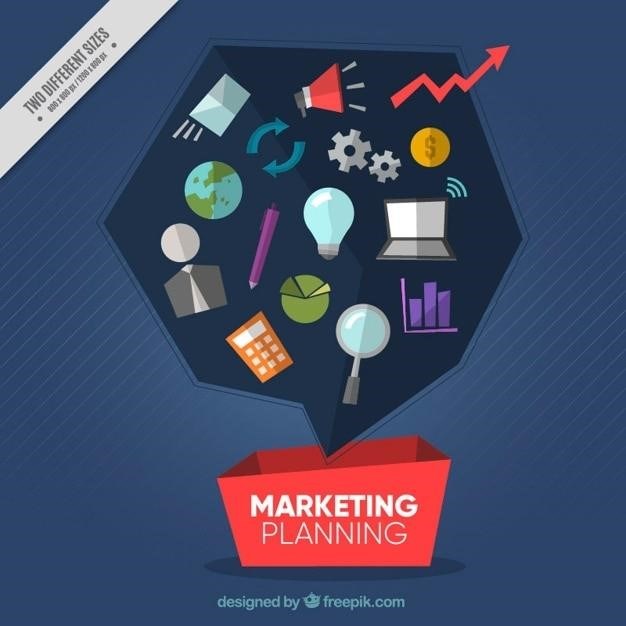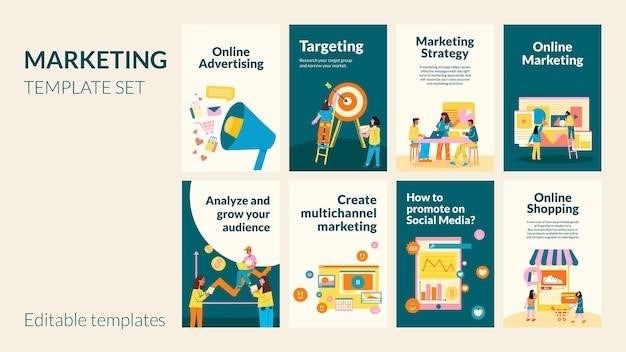Marketing Strategies for Small Businesses⁚ A Comprehensive Guide
This comprehensive guide provides a roadmap for small businesses to navigate the complex world of marketing, covering everything from understanding your target audience to measuring and analyzing results. Discover effective strategies to build a strong brand identity, utilize digital marketing channels, leverage traditional marketing methods, and build valuable relationships.
Introduction⁚ The Importance of Marketing for Small Businesses
In today’s competitive business landscape, effective marketing is no longer a luxury but a necessity for small businesses to thrive. While small businesses may face challenges like limited resources and visibility, they hold the potential to reach new heights with the right marketing approach. Marketing plays a crucial role in building brand awareness, attracting new customers, and ultimately driving sales growth;
A well-defined marketing strategy serves as a roadmap for small businesses to navigate the complexities of reaching their target audience. By understanding the needs and preferences of their customers, small businesses can tailor their marketing efforts to create meaningful connections and foster loyalty.
Moreover, marketing enables small businesses to differentiate themselves from competitors, establish a unique brand identity, and build a strong reputation in the market. By investing in marketing, small businesses can unlock opportunities for expansion, increase profitability, and achieve sustainable growth in the long run.
Understanding Your Target Audience
At the heart of any successful marketing strategy lies a deep understanding of your target audience. This involves identifying the specific individuals or groups most likely to be interested in your products or services. By delving into their demographics, psychographics, and buying behavior, you can tailor your marketing messages and campaigns to resonate with them effectively.
Conducting thorough market research is essential to gain insights into your target audience. This can involve surveys, focus groups, and analyzing data from social media and online platforms. By understanding their needs, pain points, and aspirations, you can position your offerings as solutions to their problems and create compelling value propositions.
Once you have a clear understanding of your target audience, you can segment them into different groups based on shared characteristics. This allows you to create personalized marketing messages that address their specific needs and interests. By focusing your efforts on the right segments, you can maximize the impact of your marketing campaigns and achieve better results.
Developing a Strong Brand Identity
A strong brand identity is crucial for a small business to stand out in a crowded marketplace. It’s more than just a logo or tagline; it’s a consistent and memorable representation of your company’s values, personality, and unique selling proposition. A well-defined brand identity helps you connect with your target audience on an emotional level, build trust, and foster loyalty.
Start by defining your brand’s core values and mission statement; These should reflect your company’s purpose, beliefs, and aspirations. Next, develop a brand voice and tone that aligns with your target audience’s preferences and resonates with them. Consider using storytelling techniques to create a compelling narrative that encapsulates your brand’s essence.
Visual elements play a vital role in shaping your brand identity. Design a distinctive logo that captures your brand’s personality and is easily recognizable. Create a consistent brand style guide that outlines your color palette, typography, imagery, and overall visual aesthetic. Apply this style guide across all your marketing materials, website, and social media channels to ensure a cohesive and impactful brand experience.
Utilizing Digital Marketing Channels
In today’s digital age, small businesses can’t afford to ignore the power of online marketing. Digital channels offer a cost-effective and efficient way to reach a wide audience, engage with potential customers, and drive sales. From social media marketing to search engine optimization (SEO), email marketing, and content marketing, there are numerous digital strategies to explore.
A well-executed digital marketing strategy should be tailored to your specific business goals and target audience. Start by identifying the most relevant digital channels for your industry and customer base. For example, if you cater to a younger demographic, social media platforms like Instagram and TikTok might be more effective than traditional channels like print advertising.
It’s crucial to track and analyze the performance of your digital marketing campaigns to ensure you’re getting the most out of your investment. Use analytics tools to monitor website traffic, social media engagement, email open rates, and other key metrics. Regularly evaluate your strategies and make adjustments as needed to optimize your results.
Social Media Marketing
Social media platforms have become an integral part of modern marketing, offering small businesses a powerful tool to connect with their target audience, build brand awareness, and drive sales. With billions of active users worldwide, platforms like Facebook, Instagram, Twitter, LinkedIn, and TikTok provide unparalleled reach and engagement opportunities.
To make the most of social media marketing, it’s crucial to develop a consistent strategy that aligns with your overall marketing goals. Start by identifying the platforms most relevant to your target audience and industry. Then, create compelling content that resonates with your followers, shares valuable information, and promotes your products or services.
Regularly engage with your followers by responding to comments, answering questions, and running contests or giveaways. Utilize social media advertising to reach a broader audience and target specific demographics. By consistently creating high-quality content and engaging with your followers, you can build a loyal community and drive meaningful results through social media marketing.
Search Engine Optimization (SEO)
Search engine optimization (SEO) is the process of improving your website’s visibility in organic search results. When done effectively, SEO can drive significant traffic to your website, leading to increased brand awareness, lead generation, and ultimately, sales. The foundation of SEO lies in understanding how search engines like Google crawl and index websites.
This involves optimizing your website’s content, technical structure, and user experience to make it more appealing to search engines. Keyword research is crucial to identify the terms your target audience is using to search for products or services like yours. By incorporating these keywords naturally into your website content, you increase your chances of ranking higher in search results.
Building high-quality backlinks from reputable websites is another essential aspect of SEO. Backlinks signal to search engines that your website is trustworthy and relevant, boosting its authority and ranking. Regularly monitoring your SEO performance through analytics tools is essential to identify areas for improvement and ensure your strategy remains effective.
Email Marketing
Email marketing remains a powerful and cost-effective channel for reaching your target audience. It allows you to build relationships with your customers, nurture leads, and promote your products or services directly to their inbox. The key to successful email marketing lies in creating engaging and valuable content that your subscribers will actually want to read. Segmenting your email list based on demographics, interests, or purchase history can help you tailor your messages for maximum impact.
A well-designed email campaign should include a clear call to action, encouraging recipients to take the desired next step, whether it’s visiting your website, making a purchase, or signing up for a webinar. Regularly monitor your email campaign performance through metrics like open rates, click-through rates, and conversions. This data will help you optimize your email strategy and ensure you’re reaching your target audience effectively.
Email marketing platforms can automate many aspects of your email campaigns, from list management and segmentation to sending personalized messages and tracking results. By leveraging these tools, you can streamline your email marketing efforts and focus on creating high-quality content that resonates with your audience.
Content Marketing
Content marketing is a powerful strategy for attracting and engaging your target audience. By creating and sharing valuable, relevant, and consistent content, you can establish yourself as an authority in your industry and build trust with potential customers. This approach goes beyond simply promoting your products or services; it focuses on providing information that educates, entertains, or inspires your audience.
Content marketing can take many forms, including blog posts, articles, videos, infographics, ebooks, webinars, and social media updates. The key is to choose content formats that align with your audience’s preferences and interests. For example, if your target audience is primarily visual, you might focus on creating engaging videos or infographics. If they are more interested in in-depth information, you might create ebooks or white papers.
A successful content marketing strategy requires planning and consistency. Develop a content calendar that outlines the topics you will cover, the formats you will use, and the platforms where you will share your content. Promote your content through social media, email marketing, and other channels to reach a wider audience.

Leveraging Traditional Marketing Methods
While digital marketing has become increasingly dominant, traditional marketing methods still hold significant value for small businesses, especially when used strategically. These methods offer a unique way to reach specific audiences and build relationships within local communities. Print advertising, direct mail, and public relations can effectively target niche markets that may not be easily reached through online channels.
Print advertising, such as local newspaper ads or flyers, can be a cost-effective way to reach a geographically defined audience. Direct mail campaigns, including postcards or brochures, can be highly personalized, allowing you to target specific demographics and interests. Public relations efforts, such as press releases or community events, can build credibility and generate positive media coverage.
The key to success with traditional marketing methods lies in understanding your target audience and tailoring your message accordingly. Measure the effectiveness of your campaigns through tracking response rates, website traffic, and customer feedback. By combining traditional marketing tactics with digital strategies, small businesses can create a well-rounded marketing approach that maximizes reach and engagement.
Building Relationships and Networking
In the competitive landscape of small businesses, cultivating strong relationships and networking are crucial for growth and success. Building a network of like-minded individuals, potential clients, and industry professionals can lead to valuable partnerships, referrals, and increased brand visibility. Participating in industry events, joining professional organizations, and attending local business meetings can provide opportunities to connect with key players in your field.
Cultivate meaningful relationships by engaging in authentic conversations, sharing valuable insights, and offering genuine assistance. Building trust and rapport takes time, so be patient and consistent in your efforts. Leverage social media platforms to connect with potential partners, share industry news, and engage in meaningful discussions. Actively seek out opportunities to collaborate with other businesses, offering joint promotions or cross-marketing initiatives.
Remember, networking is not just about exchanging business cards; it’s about building genuine connections and establishing yourself as a valuable resource. By investing in relationships and building a strong network, small businesses can unlock a wealth of opportunities for growth and success.
Measuring and Analyzing Results
In the dynamic world of marketing, it’s essential to track your efforts and measure the impact of your strategies. This data-driven approach allows you to identify what’s working, what needs improvement, and how to optimize your campaigns for better results. Start by defining clear goals for your marketing initiatives, such as increasing website traffic, generating leads, or boosting sales. These goals will serve as benchmarks against which you can measure your progress.
Utilize analytics tools to track key metrics, such as website visits, social media engagement, email open rates, and conversion rates. Analyze this data to understand customer behavior, identify trends, and gain insights into what resonates with your target audience. Regularly review your marketing performance and make necessary adjustments to your strategies based on the data you gather. Experiment with different tactics and track the results to determine what yields the best return on investment.
Remember, data is your guide to success in marketing. By closely monitoring your campaigns and analyzing the results, you can make informed decisions to optimize your strategies and achieve your business objectives.
Budgeting and Resource Allocation
Developing a well-defined marketing budget is crucial for small businesses, as it ensures that resources are allocated strategically and effectively. Start by identifying your financial constraints and setting realistic budget limits. Consider the various marketing channels you plan to utilize, such as online advertising, social media campaigns, content creation, and traditional media outreach. Allocate budget portions to each channel based on their potential return on investment and alignment with your overall marketing goals.
Prioritize your marketing initiatives by focusing on those with the highest potential to generate leads, drive sales, and increase brand awareness. Allocate more resources to these high-priority efforts while strategically managing spending on less impactful activities. Regularly review your budget and make adjustments as needed to ensure that your marketing investments remain aligned with your evolving business needs and market conditions.
Remember, effective budgeting is a key component of a successful marketing strategy. By allocating resources wisely and prioritizing your efforts, you can maximize the return on your marketing investments and drive growth for your small business.
The Key to Success
In the competitive landscape of today’s market, effective marketing is no longer a luxury but a necessity for small businesses to thrive. By embracing the strategies outlined in this guide, small businesses can establish a strong brand identity, reach their target audience, and build lasting relationships with customers. Remember that consistency is key. Develop a comprehensive plan, implement it diligently, and continually refine your approach based on data and feedback. Don’t be afraid to experiment with different tactics and find what works best for your specific business.
The journey to marketing success is not a sprint but a marathon. Stay committed to your goals, adapt to changing market dynamics, and leverage the power of technology to enhance your marketing efforts. By following these principles and constantly striving for improvement, small businesses can unlock their full potential and achieve sustainable growth in the competitive marketplace.
Appendix⁚ Resources and Tools

To further support your small business marketing endeavors, here is a curated list of valuable resources and tools⁚
- U.S. Small Business Administration (SBA)⁚ The SBA offers a wealth of resources, including free marketing guides, workshops, and loan programs specifically designed for small businesses.
- Adobe Digital Academy⁚ This online platform provides free courses and certifications on digital marketing, content creation, and AI literacy, equipping you with the skills to thrive in the modern workforce.
- HubSpot⁚ This comprehensive marketing platform offers a free CRM, email marketing tools, and social media management features to streamline your marketing efforts.
- Google Analytics⁚ This free web analytics tool provides valuable insights into your website traffic, user behavior, and marketing campaign performance.
- Canva⁚ This intuitive design platform offers a wide range of templates and tools to create professional-looking marketing materials, such as social media posts, presentations, and brochures.
By leveraging these resources and tools, small businesses can access valuable information, streamline their marketing processes, and ultimately achieve greater success in the competitive marketplace.
